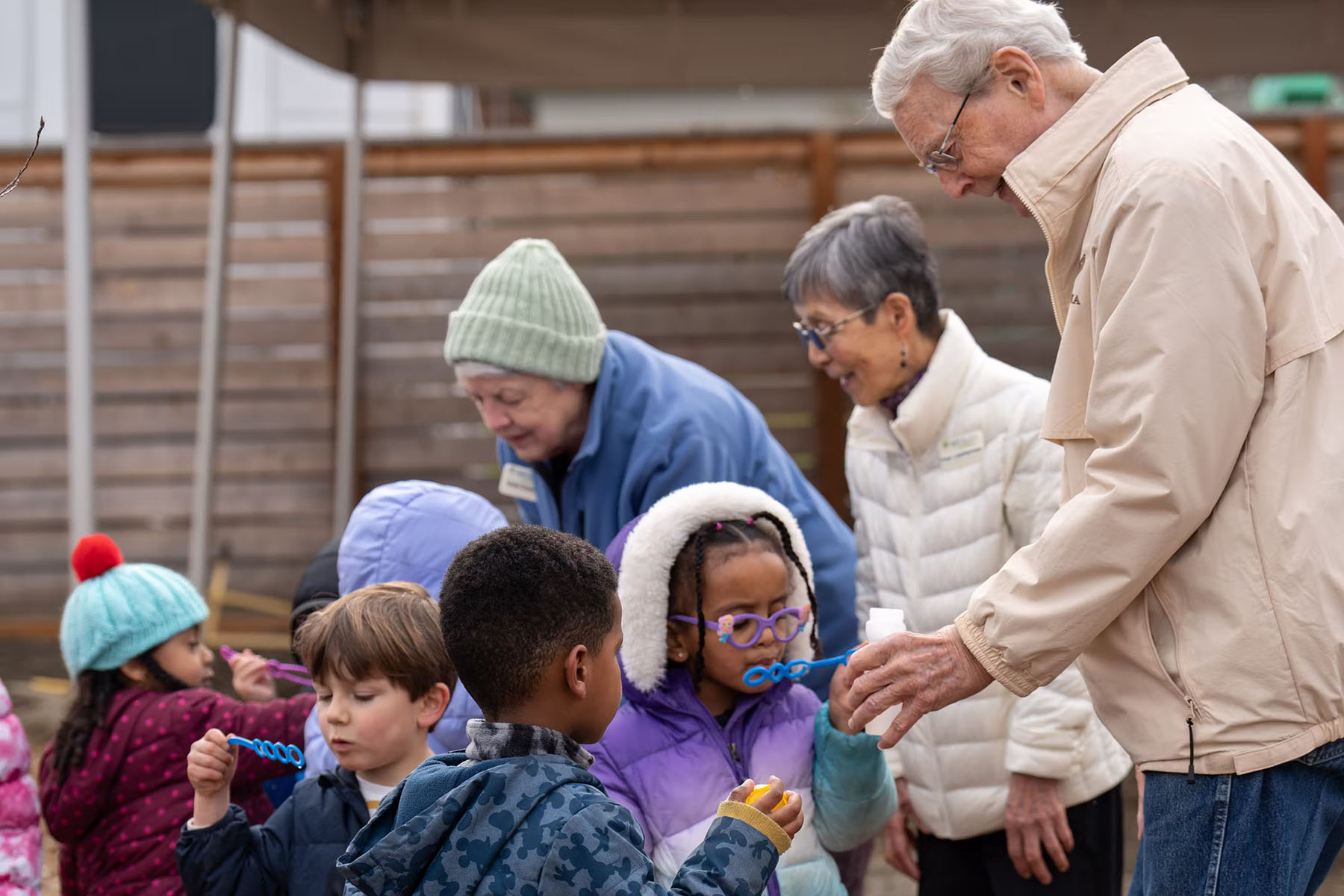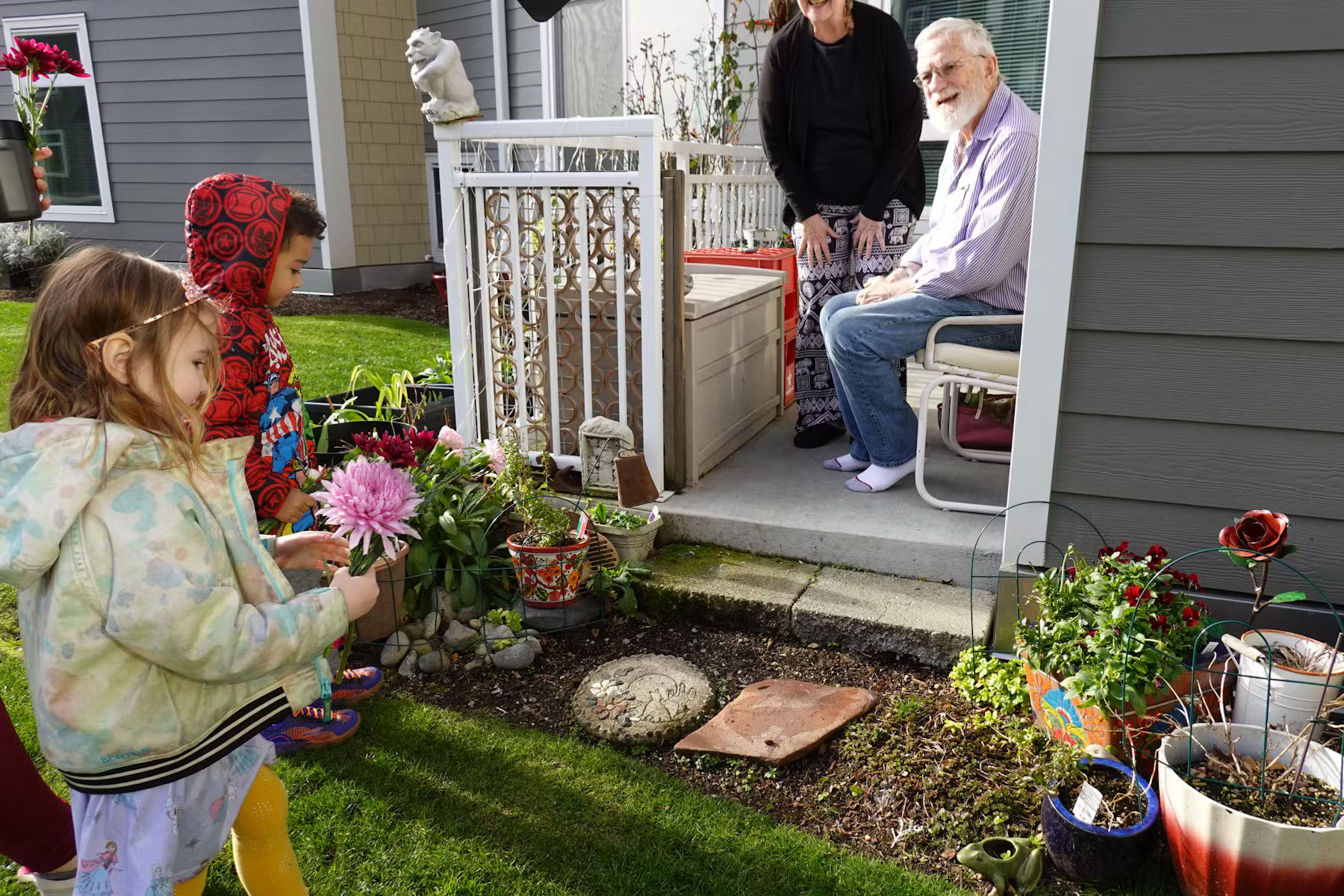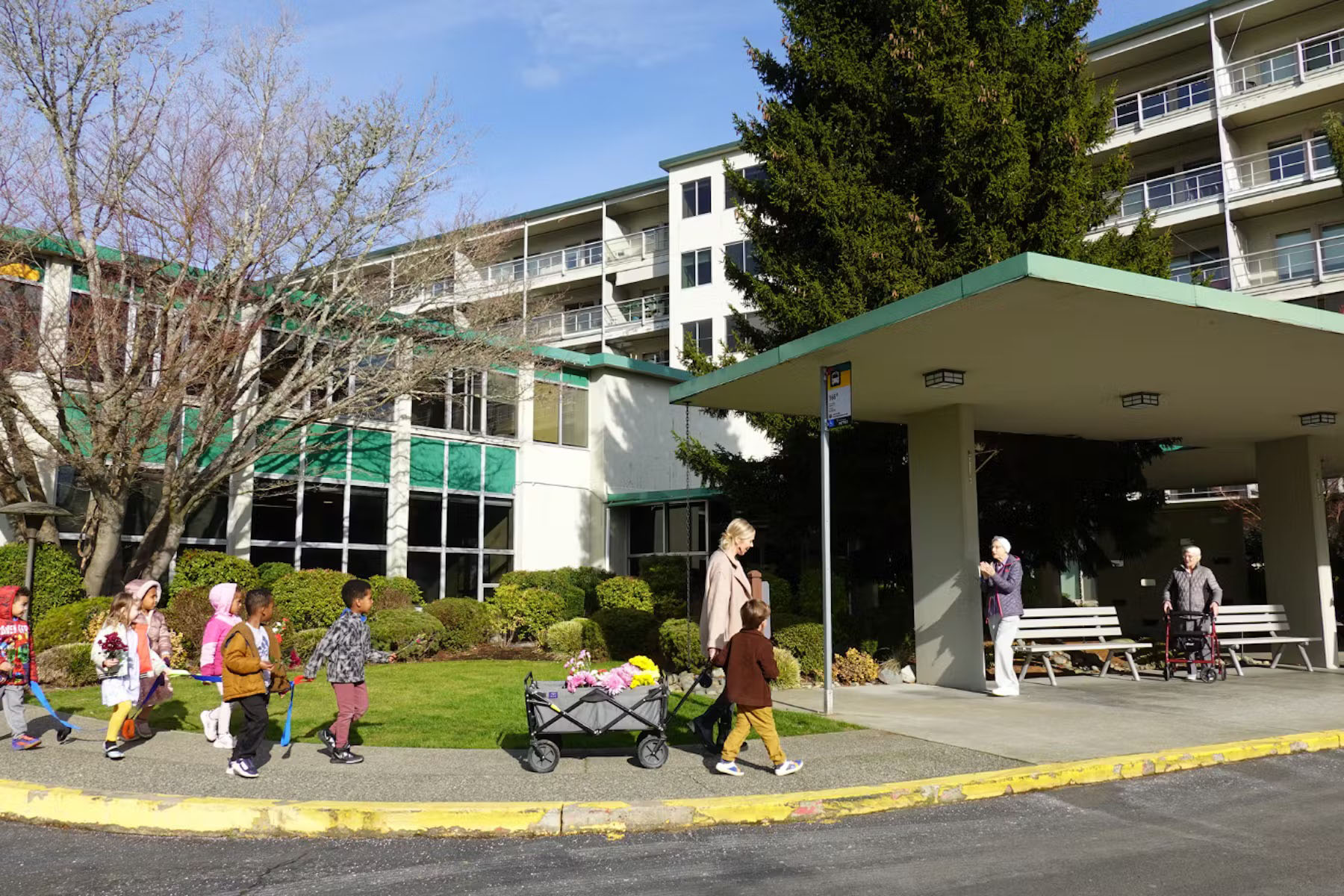This story was originally published by EdSurge.
Several times a week, teachers at Tiny Images, an early learning program in Fairmont, Nebraska, load up babies and toddlers into four- and six-seater carts and take the children on “buggy rides” through the building.
They stop first to visit residents in the assisted living wing before continuing on to those in the nursing home.
“Just walking down the hall and seeing kids’ faces light up — or residents’ faces light up — it makes your whole day,” says Kaci Brandt, director of Tiny Images, which is located inside Fairview Manor, a city-owned, nonprofit nursing home in the rural community of about 600.
The rides present children with an informal opportunity to interact with their “grandfriends,” with whom they share a daytime address, popping into residents’ rooms and seeing who’s out and about in the common areas. The children will talk and sing songs to the seniors. Sometimes they’ll keep the older adults company during breakfast.
“You can have a person who might be having a bad day,” says Tami Scheil, administrator of Fairview Manor, “and then you see a whole cart of little children coming down the hallway. It truly brightens their day.”
These heartwarming moments are good for more than just photo ops. Research shows that intergenerational facilities such as Fairview Manor can lead to physical and cognitive health benefits for both children and seniors. They also are cost effective and support workforce development in two industries where money and staff are often in short supply.
Yet despite their many advantages, intergenerational care centers remain uncommon. As of 2021, fewer than 150 such facilities operated in the United States, according to Donna Butts, executive director of Generations United, a nonprofit that advocates for intergenerational policies and programming.
That may be changing. In the last few years, there has been more interest in creating and expanding co-located elder and child care programs, as onlookers realize that, while the challenges of these shared sites exist, they are far from insurmountable.
“Intergenerational shared sites — we think they really are the way of the future,” says Butts.
‘That spark of life’

Beyond buggy rides, children at Tiny Images participate in planned activities with long-term care residents about two to three times a week, says Brandt.
In the recent past, children and residents played a game of makeshift table tennis using balloons and pool noodles. They built sand castles out of “cloud dough” (a mixture of flour and baby oil). They painted on canvases using squirt guns instead of paintbrushes. And last month, they decorated sugar cookies for the holidays.
Such activities are great for children. They’re developing their motor skills, socializing, and engaging in play and free expression. But these interactions are just as helpful for adults, who also benefit from movement, art therapy and socialization.
Most experts agree that older adults as a population tend to be isolated and lonely — problems associated with an increased risk of dementia, heart disease and stroke, according to Jina Ragland, associate state director of advocacy and outreach at AARP Nebraska. As they age, their social networks contract. Increasingly, many seniors live far away from their children and grandchildren. And those living in long-term care facilities tend to have very structured days, says Scheil at Fairview Manor. In many nursing homes, each day follows the same routine, monotony blurring into boredom and even depression for some.
The presence of children can turn all of that around.
“Let me tell you, when you have kids in a building, and the kids are running around and providing that variety and that spontaneity, our residents are not bored,” says Scheil. “Kids are not predictable. They just provide that spark of life.”
Tiny Images has been operating inside Fairview Manor for more than 20 years. It is the only center-based child care option in town, with up to 36 children attending at any one time, says Scheil.
Across Nebraska, Tiny Images is among a handful of intergenerational facilities. But soon there will be more. Earlier this year, the state legislature passed a bill to fund the creation of more co-located care centers.
The bill includes a modest $300,000, with up to $100,000 per facility, but the idea is that this startup funding can set a precedent, says Ragland of AARP Nebraska. It aims to establish a proof of concept that other facilities in Nebraska — and nationwide — can follow.
Building belonging and purpose

Another source of momentum propelling these arrangements is the Bezos Academy, a network of tuition-free, Montessori-inspired preschools funded by Amazon founder and billionaire Jeff Bezos.
Bezos Academy preschools — of which there are now 25, with another 11 slated to open by the end of 2025 — operate in a variety of settings, including public schools and public housing. Program leaders are generally looking to establish preschools at sites that are run by mission-driven organizations with some empty space they can rent for no or low cost, a spokesperson for Bezos Academy said. Elder care facilities have emerged as a natural fit.
The inaugural Bezos Academy preschool site, launched in 2020, is co-located in a standalone building on the campus of Wesley Homes, a senior living community in Des Moines, Washington. Bezos Academy has since opened a second co-located preschool in Texas and has announced plans to open two more — one in Arizona in 2025 and another in Dallas in 2026.
At Bezos Academy Des Moines, children ages 3 to 5 attend preschool in a building just a short walk from the residents of Wesley Homes. At the beginning of each school year, families sign off on “field trips” the children will take to visit the seniors.
“It’s a regular part of every week at our school,” says Tara Requa, head of school at Bezos Academy Des Moines.
The teachers take small groups of children — two to four at a time — over to the residents’ buildings for “reading corner” during the week, and on Fridays, the entire class walks over to Wesley Homes for a planned activity (these are dubbed “Fun Fridays”), with some children heading to the assisted living facility and others visiting those in memory care. In November, one such Friday activity involved making homemade playdough and using cookie cutters to create shapes.
Beyond the weekly encounters, children and residents also team up for events throughout the school year — they’ve produced a play and held a puppet show. Last year, a group of particularly handy residents designed and built the preschoolers a “mud kitchen” — essentially, an outdoor kitchen used for pretend play.
“We’re reducing isolation,” says Requa. “There’s just so much joy. On Friday, we walked in the door, and there’s this whole waiting committee. We were met with cheers. They kind of wait for us to come — it’s very exciting. There’s an amazing sense of belonging and purpose. We’re doing things, putting things on their calendar they wouldn’t otherwise have.”
Requa, along with many other proponents of intergenerational facilities, notes how valuable it is for young children to be around older adults. Even children who see their grandparents regularly likely aren’t around relatives of this age or ability very often, notes Scheil at Fairview.
The exposure helps to combat ageism and ableism, but it’s also building empathy: Children in intergenerational facilities don’t really see the wheelchairs and walkers, Requa says; they just see Linda and know that Linda uses a wheelchair because her legs hurt and the wheelchair helps her body.
Hurdles, not brick walls

One allure of these arrangements is that many early learning programs are getting to rent the space for nothing — or next to nothing — which is a huge cost savings for a field whose providers are nearly always trying to make the math work to balance their budgets.
But there are other cost efficiencies too. Many co-located programs will share a kitchen and food service staff — at Tiny Images, lunch is prepared and delivered by nursing home staff. They’ll often use the same maintenance staff, and occasionally they’ll do mealtime together, even if it’s just for snacks.
Some intergenerational programs will also give the staff of long-term care facilities priority for child care slots in the co-located program.
It’s a big draw to have your child in the same place as you during your workday, notes Kierstin Reed, president and CEO of LeadingAge Nebraska, a state affiliate of the national association by the same name which provides education, advocacy and support to service providers for seniors.
But it can also be necessary. Many staff at senior care facilities work nontraditional hours and long shifts, while child care programs rarely provide care outside of normal business hours.
“This is an opportunity to accommodate those workers,” notes Ragland of AARP Nebraska.
That kind of workplace benefit could be the difference between a nurse staying or leaving her position at a long-term care facility, says Ragland. And turnover in a nursing home can lead to a breakdown in the quality of care residents receive.
Still, these facilities are not without their downsides.
The most obvious drawback is the risk of illness. Early care and education settings are notorious for transmitting viruses. Young children are often putting their hands in their mouths and touching everything and everyone, and they are still learning good hygiene habits.
“Kids unfortunately bring a lot of germs,” admits Ragland. “You don’t want children who are sick passing on something to a very vulnerable adult who has a weak immune system.”
The combination of those two populations does create a challenge, but many intergenerational facilities successfully manage it, even during cold and flu season. It just requires good protocols for cleanliness, health and safety, says Butts of Generations United.
The other barrier is regulations. Senior care is a highly regulated industry. Early care and education is also highly regulated. When you put the two together and have to navigate both sets of requirements, it can be onerous.
Ultimately, though, illnesses and regulations are just hurdles, not brick walls. And seemingly anyone who has worked in an intergenerational facility — and many who have visited them — believe that the benefits are overwhelming and the joy is too infectious to deny.
Intergenerational work “does take a commitment. It’s time intensive, and there’s no playbook for it really,” says Requa of Bezos Academy Des Moines. “[But] I love it more than anything. I think it’s my favorite part of this job.”
After 28 years at Fairview Manor, including the last 22 in which Tiny Images has been operating inside it, Scheil would agree.
“I can’t imagine,” she says, “running a nursing home without children in it.”







